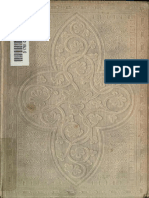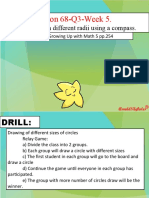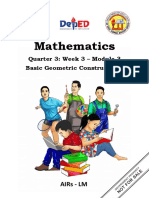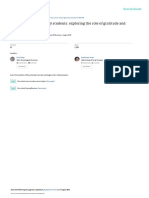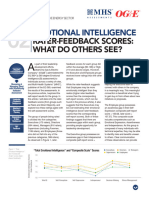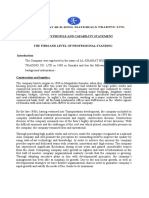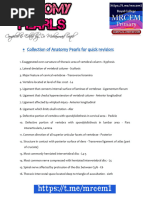Class 6 Maths Chapter 14 Revision Notes
Class 6 Maths Chapter 14 Revision Notes
Uploaded by
Neha TiwariCopyright:
Available Formats
Class 6 Maths Chapter 14 Revision Notes
Class 6 Maths Chapter 14 Revision Notes
Uploaded by
Neha TiwariCopyright
Available Formats
Share this document
Did you find this document useful?
Is this content inappropriate?
Copyright:
Available Formats
Class 6 Maths Chapter 14 Revision Notes
Class 6 Maths Chapter 14 Revision Notes
Uploaded by
Neha TiwariCopyright:
Available Formats
Revision Notes
Class 6 - Maths
Chapter 14 - Practical Geometry
The methods for sketching geometrical forms are covered in this chapter.
● To create shapes, we employ the following mathematical instruments:
1. A graduated ruler –
o Along one edge, a ruler graduated in centimetres (and sometimes
into inches along the other edge).
o It is used to draw and measure the line segments.
2. The compass –
o It is a pair of a pencil on one end and a pointer on the other.
o It is used not to measure the equal lengths, but to mark them off.
o Also, it is used to make circles and arcs.
3. The divider –
o It is a pair of pointers.
o It is used to compare the lengths.
4. Set-squares –
o Set squares are the two triangular pieces, one with 450 , 450 and 900
angles at the vertices and the other with 300 ,600 and 900 angles.
o It is used to draw the parallel and perpendicular lines.
5. The protractor –
o It is used to measure the angles.
o It is like a semi-circular scale with markings as angles.
● The following constructions can be created with the ruler and compass:
1. A circle can be drawn only when the length of its radius is known.
2. A line segment can be drawn when its length is given.
3. Same procedure follow for the line segment.
4. A perpendicular to a line can be drawn through a point
a. On the line
b. Not on the line.
5. The perpendicular bisector of a line segment of given length can be
drawn.
6. An angle can be drawn for a given measure.
7. A copy of an angle.
8. The bisector of a given angle.
Class VI Maths www.vedantu.com 1
9. Some angles of special measures such as
a. 900
b. 450
c. 600
d. 300
e. 1200
f. 1350
Construction of a circle when its radius is known:
Step 1 : Open the compass for the required given radius.
Step 2 : Mark a point with a sharp pencil to denote where the centre of the circle
has to be. Name it as O .
Step 3 : Place the pointer of the compass on O .
Step 4 : Now, turn the compass slowly either in clockwise or anticlockwise
direction such that the pencil traces the circle of required radius. Care must be
taken to complete the movement at one go.
Construction of a line segment of a given length:
A better method would be to construct a line segment of a given length with
compass.
Draw a line for 3 cm by using following steps.
Step 1 : Draw a line l and make a point A on line l .
Step 2 : Place the pointer of the compass at the zero mark of the ruler. Extend the
other leg of the compass upto the 3 cm mark on the ruler.
Class VI Maths www.vedantu.com 2
Step 3 : Taking caution that the opening of the compass has not changed, place
the pointer on A and swing an arc to cut l at B .
Step 4 : AB is a line segment of required length.
Constructing a copy of a given line segment:
A better technique would be to construct line segment with a ruler and compass.
Following steps shows how to draw AB .
Step 1 : Given AB whose length is not known.
Class VI Maths www.vedantu.com 3
Step 2 : Fix the compass pointer on A and the pencil end on B .
The distance between the two open legs of the instrument now gives the length
of AB .
Step 3 : Draw any line l .
Choose a point C on l .
Without changing the compass setting, place the pointer on C .
Step 4 : Swing an arc that cuts l at a point, say, D .
Now CD is a copy of AB .
Method of ruler and compass:
Step 1 : Given a point P on a line l .
Class VI Maths www.vedantu.com 4
Step 2 : With P as centre and a convenient radius, construct an arc intersecting
the line l at two points A and B .
Step 3 : With A and B as centres and a radius greater than AP construct two
arcs, which cut each other at Q .
Step 4 : Join PQ .
Then PQ is perpendicular to l .
We write PQ ⊥ l
Constructing a copy of an angle of unknown measure:
We have to use only a straight edge and the compass for constructing an angle
whose measure is unknown.
With the help of following steps, we can draw an unknown angle A
Class VI Maths www.vedantu.com 5
Step 1 : Draw a line l and choose a point P on it.
Step 2 : Place the compass at A and draw an arc to cut the rays of A at B and
C.
Step 3 : Maintaining the same settings on the compass, draw an arc with P as
centre, cutting l in Q .
Step 4 : Set compass to the length BC with the same radius.
Class VI Maths www.vedantu.com 6
Step 5 : Place the compass pointer at Q and draw the arc to cut the arc drawn
earlier in R .
Step 6 : Join PR . This gives us P . It has the same measure as A .
This means QPR has same measure as BAC .
Class VI Maths www.vedantu.com 7
You might also like
- Fedora Terminal CommandsDocument17 pagesFedora Terminal CommandsMohammed Abdul NadeemNo ratings yet
- Exercices - BasinsDocument9 pagesExercices - BasinsAysel YusifovaNo ratings yet
- Mathematics: Quarter 3 - Module 7: Construct Triangles, Squares, Rectangles, Regular Pentagons, and Regular HexagonsDocument29 pagesMathematics: Quarter 3 - Module 7: Construct Triangles, Squares, Rectangles, Regular Pentagons, and Regular HexagonsEuchel Pauline RamosNo ratings yet
- Mathematics Lesson Plan For Junior High SchoolDocument12 pagesMathematics Lesson Plan For Junior High SchoolCahya Putri Prayogi80% (5)
- Constructing AnglesDocument7 pagesConstructing AnglesCourtney 'Jackworld' JackNo ratings yet
- Star Wars Rules Companion PDFDocument81 pagesStar Wars Rules Companion PDFFabricio Moreira100% (6)
- Handbook To The Cathedrals of England-Tom6 PDFDocument286 pagesHandbook To The Cathedrals of England-Tom6 PDFPrivremenko Jedan100% (2)
- The Following Are The Steps in Constructing Perpendicular Bisector of A Segment Using A Compass and A StraightedgeDocument4 pagesThe Following Are The Steps in Constructing Perpendicular Bisector of A Segment Using A Compass and A StraightedgeAnjelo Amar BarcenasNo ratings yet
- MIDTERM-GEOMETRICAL-CONSTRUCTIONDocument11 pagesMIDTERM-GEOMETRICAL-CONSTRUCTIONrodnelpaz43No ratings yet
- Practical GeometryDocument4 pagesPractical GeometrypravetagattaniNo ratings yet
- Unit MDocument10 pagesUnit MASHOK SINHA KARANAMNo ratings yet
- Geometric Construction 1Document18 pagesGeometric Construction 1aryanNo ratings yet
- Drawing Module NewDocument51 pagesDrawing Module Newtonychisenga05No ratings yet
- Engineering Drawing N1 Module 4Document16 pagesEngineering Drawing N1 Module 4splarsh0No ratings yet
- Construction Answer KeyDocument31 pagesConstruction Answer KeyalwaysankitaNo ratings yet
- Geometric Construction 1Document17 pagesGeometric Construction 1Padamati PranavsaiNo ratings yet
- Geometric ConstructionsDocument54 pagesGeometric ConstructionsAmit TiwaryNo ratings yet
- Geometric ConstructionDocument30 pagesGeometric ConstructionHarshika100% (1)
- Geometric ConstructionDocument7 pagesGeometric ConstructionJohara Bayabao-AngniNo ratings yet
- Module in Mathematics 7: Department of Education-National Capital Region Schools Division of Pasay CityDocument20 pagesModule in Mathematics 7: Department of Education-National Capital Region Schools Division of Pasay CityTorres Jhon Chriz GabrielNo ratings yet
- Access NCERT Solutions For Class 6 Chapter 14 - UpDocument5 pagesAccess NCERT Solutions For Class 6 Chapter 14 - UpKamjith PadinjareveeduNo ratings yet
- Access NCERT Solutions For Class 6 Chapter 14 - UpDocument5 pagesAccess NCERT Solutions For Class 6 Chapter 14 - UpKamjith PadinjareveeduNo ratings yet
- Fieldwork 2 - Hadi, Martina Bianca ODocument11 pagesFieldwork 2 - Hadi, Martina Bianca Omaria leonoraNo ratings yet
- Construction of PolygonDocument57 pagesConstruction of Polygoniam whatiamNo ratings yet
- Moderngeometry 170614050549Document57 pagesModerngeometry 170614050549Apolonio ManarangNo ratings yet
- Practical Geometry NotesDocument6 pagesPractical Geometry NotesMidhun Bhuvanesh.B 7ANo ratings yet
- Chapter 14 Practical GeometryDocument38 pagesChapter 14 Practical GeometryVARUNI 3484No ratings yet
- Math 5 - Lesson 68-Wk 5 q3Document18 pagesMath 5 - Lesson 68-Wk 5 q3Riza GusteNo ratings yet
- Ncert Solutions Class 7 Math Chapter 10 Practical GeometryDocument18 pagesNcert Solutions Class 7 Math Chapter 10 Practical GeometrySatvik Anand SinghNo ratings yet
- Construction PDFDocument6 pagesConstruction PDFSahasra SagiNo ratings yet
- Practical Geometry Class 8 Notes Chapter 4Document7 pagesPractical Geometry Class 8 Notes Chapter 4apex anvitNo ratings yet
- Lesson Plan Bisecting Lines and AnglesDocument2 pagesLesson Plan Bisecting Lines and AnglesSamir RichardsonNo ratings yet
- Q3 Math7 Week 3 Module 3 Maryjane A. GacusanDocument16 pagesQ3 Math7 Week 3 Module 3 Maryjane A. GacusanCynthia TulopNo ratings yet
- Engineering Drawing - Chapter FourDocument31 pagesEngineering Drawing - Chapter FourEmmanuel EduafulNo ratings yet
- Aadarsh Solutions Class-6Document17 pagesAadarsh Solutions Class-6editorshekharNo ratings yet
- Basic Constructions PDFDocument5 pagesBasic Constructions PDFASHISH KUMARNo ratings yet
- ML Aggarwal Solutions Class 10 Maths Chapter 16Document14 pagesML Aggarwal Solutions Class 10 Maths Chapter 16HARE KRISHNANo ratings yet
- Bisecting Angles Lesson 2Document4 pagesBisecting Angles Lesson 2Sharon Jn CharlesNo ratings yet
- Lecture 8 - Isometric Drawings CircleDocument8 pagesLecture 8 - Isometric Drawings Circleس0% (1)
- Taping Problems and TechniquesDocument6 pagesTaping Problems and TechniquesSophia Ellaine LuzaritaNo ratings yet
- LAS Week 4 - MELC 37Document4 pagesLAS Week 4 - MELC 37Angelo Rey NavaNo ratings yet
- JSS2 Second Term Basic Technology NoteDocument17 pagesJSS2 Second Term Basic Technology NoteJohn EgbongNo ratings yet
- MATH7 Q3 WEEK4 HYBRID2Document17 pagesMATH7 Q3 WEEK4 HYBRID2ROWENA MAE FANUNCIONo ratings yet
- MATH G7 - Q3 - M5 (18pages) PDFDocument18 pagesMATH G7 - Q3 - M5 (18pages) PDFVirgilio VergaraNo ratings yet
- Mensuration and Practical GeometryDocument12 pagesMensuration and Practical Geometrydocuments unaisNo ratings yet
- LAMPIRAN A - Urus Niaga Tugasan 2019 - UpdatedDocument4 pagesLAMPIRAN A - Urus Niaga Tugasan 2019 - UpdatedReds Vharshan MahandrenNo ratings yet
- 7 - Basic ShapesDocument20 pages7 - Basic ShapesNavya NarangNo ratings yet
- Using The Compass To Construct Circles and Arcs Activity Booklet-1Document6 pagesUsing The Compass To Construct Circles and Arcs Activity Booklet-1Shahrazad8No ratings yet
- Math 7 - Quarter 3 - Module 6Document18 pagesMath 7 - Quarter 3 - Module 6arlyn.ferolinNo ratings yet
- Ncert Solutions Class 6 Maths Chapter 14 Ex 14 3Document4 pagesNcert Solutions Class 6 Maths Chapter 14 Ex 14 3varsha dubeyNo ratings yet
- Chapter 12 Construction and LociDocument17 pagesChapter 12 Construction and LociAtif Muhammad100% (1)
- Guía 4 - GeometríaDocument10 pagesGuía 4 - GeometríaGabriela Plata VegaNo ratings yet
- Yr10 TD Plan wk8 9 10Document19 pagesYr10 TD Plan wk8 9 10Chilekezi DanielNo ratings yet
- Q3 MATH 7 Module 3 With Answer KeyDocument17 pagesQ3 MATH 7 Module 3 With Answer KeyRogelyn CustodioNo ratings yet
- Chain SurveyingDocument3 pagesChain SurveyingAhmadGhanem100% (1)
- Construction of The PentagonDocument5 pagesConstruction of The PentagonZharko MatichNo ratings yet
- Bearings 3Document9 pagesBearings 3fathimalanabza842No ratings yet
- FW 3 Taping Problems and TechniquesDocument6 pagesFW 3 Taping Problems and Techniquesdavidbautista0119No ratings yet
- Loci Mechanisms NotesDocument3 pagesLoci Mechanisms NotesoluganyambeniNo ratings yet
- Sec 5.1 GeomDocument5 pagesSec 5.1 Geomrishab.balaji19No ratings yet
- Practical GeometryDocument8 pagesPractical GeometryMidhun Bhuvanesh.B 7ANo ratings yet
- Geometric ConstructionsDocument9 pagesGeometric Constructionsapi-262621710No ratings yet
- Indices & Standard Form F2 2013Document8 pagesIndices & Standard Form F2 2013Juan Chee WongNo ratings yet
- Fujifilm Customs FilmsDocument11 pagesFujifilm Customs FilmsJulian RuedaNo ratings yet
- Vitality in Gratitude and ResilienceDocument18 pagesVitality in Gratitude and ResilienceSavvyyNo ratings yet
- Emotional Intelligence in The Energy Sector - Part 2Document2 pagesEmotional Intelligence in The Energy Sector - Part 2Neural Network ConsultingNo ratings yet
- m1 SuvatDocument7 pagesm1 SuvatdrkhansacademyNo ratings yet
- Understanding of AlarmsDocument71 pagesUnderstanding of AlarmsAnkita TiwariNo ratings yet
- Alkhairat Company Profile (Final) Kii LamaadDocument28 pagesAlkhairat Company Profile (Final) Kii LamaadAbdulkadir HusseinNo ratings yet
- Supply Chain Risk ManagementDocument33 pagesSupply Chain Risk ManagementEqbal GubranNo ratings yet
- Examples of Introduction Paragraph With ThesisDocument5 pagesExamples of Introduction Paragraph With Thesisanaespinalpaterson100% (2)
- The PLUS+1® Controls PlatformDocument8 pagesThe PLUS+1® Controls Platformwalk111No ratings yet
- 103 - Padyamchollal - Arabic: Result:LP GeneralDocument6 pages103 - Padyamchollal - Arabic: Result:LP GeneralakgsghssNo ratings yet
- E Show Preview ITE 2023 CompressDocument10 pagesE Show Preview ITE 2023 Compresszackroo25No ratings yet
- Sienna AkoreDocument9 pagesSienna AkorewhiteNo ratings yet
- Experiment No. 1 - Soil Sampling, Labeling and StorageDocument3 pagesExperiment No. 1 - Soil Sampling, Labeling and Storageryanmalabunga31No ratings yet
- Anatomy Pearls by Dr. SaqibDocument17 pagesAnatomy Pearls by Dr. SaqibDr. Sarthak MishraNo ratings yet
- Bermuda Triangle RamayanaDocument11 pagesBermuda Triangle RamayanaT Sampath KumaranNo ratings yet
- Redefining Strategies For International MarketsDocument123 pagesRedefining Strategies For International MarketsAisha RahatNo ratings yet
- Abhinav Kumar Gupta 22.07.2020Document2 pagesAbhinav Kumar Gupta 22.07.2020Dinesh GuptaNo ratings yet
- Chikungunya VirusDocument11 pagesChikungunya VirusEvelyn Chacon Johnson100% (1)
- Pitting Trenching Activty eDocument2 pagesPitting Trenching Activty eFARHA NAAZNo ratings yet
- House of Santa: Architecture CompetitionDocument10 pagesHouse of Santa: Architecture CompetitionAhmedBIowarNo ratings yet
- Financial Management Practices of Indian Small and Medium Enterprises (SMEs) - A Study of The Food Processing SectorDocument15 pagesFinancial Management Practices of Indian Small and Medium Enterprises (SMEs) - A Study of The Food Processing SectorLouierose Joy CopreNo ratings yet
- Introduction To Chemistry 4th Edition Bauer Test BankDocument25 pagesIntroduction To Chemistry 4th Edition Bauer Test BankMaryClarkkofgx100% (63)
- Laboratory Outline - Exercise 5Document6 pagesLaboratory Outline - Exercise 5Majestic RavenNo ratings yet
- Paper B An Evaluation of The Weaknesses and Threats of Nwonyo Fishing Festival (Corrected Coppy)Document16 pagesPaper B An Evaluation of The Weaknesses and Threats of Nwonyo Fishing Festival (Corrected Coppy)INYANG, OduduabasiNo ratings yet
- Dachshund e A4Document0 pagesDachshund e A4Riadh FantarNo ratings yet






